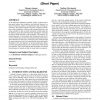425 search results - page 58 / 85 » A Fully Dynamic Algorithm for Distributed Shortest Paths |
BMCBI
2006
13 years 7 months ago
2006
Background: The main aim of this study was to develop and implement an algorithm for the rapid, accurate and automated identification of paths leading from buried protein clefts, ...
ATAL
2008
Springer
13 years 9 months ago
2008
Springer
In the multi-agent pathfinding problem, groups of agents need to plan paths between their respective start and goal locations in a given environment, usually a two-dimensional map...
BROADNETS
2007
IEEE
14 years 1 months ago
2007
IEEE
— Traffic engineering has been extensively studied to maximize network resource utilization while minimizing call blocking [1]. As the the demand for high data rate services ove...
ICDCS
2005
IEEE
14 years 1 months ago
2005
IEEE
DualPats exploits the strong correlation between TCP throughput and flow size, and the statistical stability of Internet path characteristics to accurately predict the TCP throug...
ICPPW
2006
IEEE
14 years 1 months ago
2006
IEEE
Homotopy methods to solve polynomial systems are well suited for parallel computing because the solution paths defined by the homotopy can be tracked independently. For sparse po...

